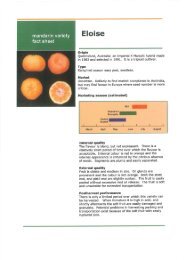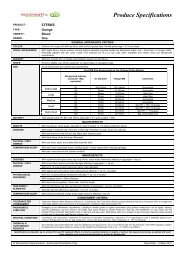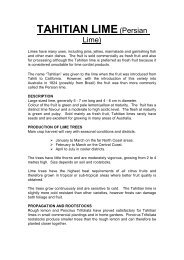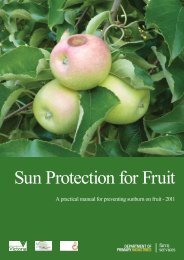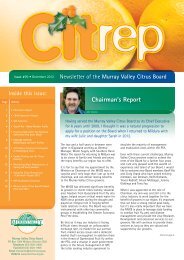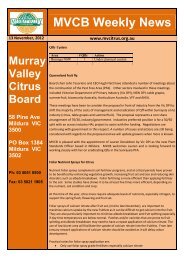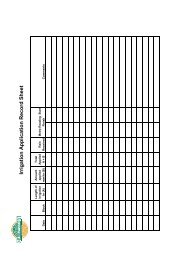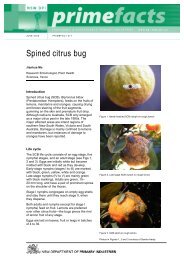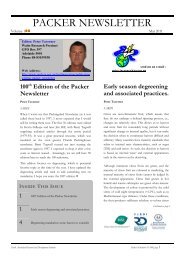Sun Protection for Apples Agnote
Sun Protection for Apples Agnote
Sun Protection for Apples Agnote
Create successful ePaper yourself
Turn your PDF publications into a flip-book with our unique Google optimized e-Paper software.
<strong>Sun</strong>burn <strong>Protection</strong> <strong>for</strong> <strong>Apples</strong> - Department of Primary Industries<br />
<strong>Sun</strong>burn <strong>Protection</strong> <strong>for</strong> <strong>Apples</strong><br />
Note Number: AG1443<br />
Published: June 2011<br />
Updated:<br />
Introduction<br />
Every year, sunburn causes some damage to fruit growing commercially in northern Victoria. <strong>Sun</strong>burnt fruit can be<br />
used <strong>for</strong> producing juice, but this often does not cover the picking and grading costs and damaged fruit is often<br />
dumped. Orchardists in the Goulburn Valley estimate fruit losses can vary from 6 to 30 per cent, depending on the<br />
season and the type of fruit. Losses in susceptible varieties like Granny Smith and Gala apples have been as high as<br />
40 to 50 per cent.<br />
What causes sunburn in apples?<br />
The energy of sunlight can cause sunburn on the sun-exposed surface of apples. The heating effect of sunlight,<br />
combined with the damaging effects of ultra-violet (UV) light are the main causes of sunburn in apples, plus the<br />
sudden movement of fruit from shade to direct sunlight can also cause sunburn, even at lower temperatures.<br />
Types of sunburn<br />
<strong>Sun</strong>burn in apples has been studied in detail and three types of sunburn have been found.<br />
1. <strong>Sun</strong>burn necrosis<br />
Fig 1. Left to right: <strong>Sun</strong>burn necrosis, <strong>Sun</strong>burn browning and Photo-oxidative sunburn<br />
(Picture from Larry Schrader)<br />
This appears as a sunken dark brown or black dead or necrotic patch on the side of fruit exposed to the sun. It is<br />
usually caused by heat generated in fruit by direct sunlight, when the fruit surface temperature of an apple reaches<br />
52º±1ºC <strong>for</strong> 10 minutes.<br />
http://new.dpi.vic.gov.au/agriculture/horticulture/fruit-nuts/pome-fruit/sunburn-protection-<strong>for</strong>...<br />
Page 1 of 5<br />
12/09/2011
<strong>Sun</strong>burn <strong>Protection</strong> <strong>for</strong> <strong>Apples</strong> - Department of Primary Industries<br />
2. <strong>Sun</strong>burn browning<br />
This appears as a yellow, brown or dark, tan patch on the side of the apple exposed to the sun. Cells do not die and<br />
damage initially appears superficial, although deeper layers may show more damage after cool storage. This is<br />
caused by less intense sunlight at lower surface temperatures on the fruit. <strong>Sun</strong>burn browning in apples normally<br />
begins to appear when fruit surface temperatures rise to 46º to 49ºC <strong>for</strong> one hour, depending on different varieties.<br />
3. Photo-oxidative sunburn<br />
This initially appears as white, bleached skin in a patch on the side of apples exposed to the sun, that later becomes<br />
brown and sometimes also necrotic. It can occur at relatively low air temperatures and with lower surface<br />
temperatures of fruit (less than 45ºC). It is associated more with a sudden increase in direct, visible light intensity,<br />
such as when a branch moves suddenly under the increased weight of the growing fruit to expose fruit that was<br />
previously shaded.<br />
<strong>Sun</strong>burn Risk<br />
Fruit surface temperature will increase with increased duration and intensity of exposure to sunlight and this provides<br />
the best indicator of sunburn risk. However air temperature is normally the most convenient indicator of sunburn risk.<br />
Orchardists should be aware that the Bureau of Meteorology air temperature measurements are always taken in<br />
shade and sun-exposed fruit surface temperatures are normally 10º to 18ºC higher than the official, measured<br />
air temperature.<br />
Shaded air temperature as an indicator of sunburn risk:<br />
•<br />
•<br />
•<br />
Greater than 40ºC = High risk of a necrotic patch<br />
Greater than 35ºC = High risk of browning damage<br />
30º to 35ºC = Damage is variable, depending on wind, sunlight intensity (cloud cover), humidity and level of<br />
fruit acclimatisation to sunlight<br />
Other factors that increase sunburn risk are:<br />
•<br />
•<br />
•<br />
•<br />
Sudden movement of fruit from shade to direct sunlight<br />
Modern orchards with dwarfing rootstocks and good light penetration<br />
Fruit positioned with a westerly aspect<br />
Water stress on hot days (evidence from grower experience)<br />
<strong>Sun</strong> <strong>Protection</strong> Options<br />
1. Best management practices <strong>for</strong> sun protection<br />
•<br />
•<br />
•<br />
•<br />
Use more heat tolerant fruit varieties. For example: Pink Lady® and <strong>Sun</strong>downer® are more tolerant than<br />
Granny Smith and Gala<br />
Schedule irrigations to avoid tree water stress<br />
Train fruit trees to develop an appropriate canopy. For example: scaffold branches that do not move and less<br />
fruit at the end of branches<br />
Avoid early and excessive summer pruning and leaf stripping to enhance colour<br />
http://new.dpi.vic.gov.au/agriculture/horticulture/fruit-nuts/pome-fruit/sunburn-protection-<strong>for</strong>...<br />
Page 2 of 5<br />
12/09/2011
<strong>Sun</strong>burn <strong>Protection</strong> <strong>for</strong> <strong>Apples</strong> - Department of Primary Industries<br />
•<br />
•<br />
•<br />
Protect picked fruit in the bin from unnecessarily extended periods of direct sunlight exposure<br />
Avoid bare inter-row spaces that reflect solar radiation<br />
Improve air movement through the fruit block<br />
2. Spray-on products<br />
Leaves and fruit of agricultural crops can be sprayed with suspensions of tiny, white, mineral particles (clay or<br />
calcium carbonate) or with wax emulsions to create a film that provides some protection from the damaging effects of<br />
sunlight.<br />
The clay products are made from processed kaolin clay and research in the United States has shown, under high<br />
application rates, they can reduce fruit surface temperatures. Under summer conditions, when sunlight levels are<br />
high, the film may promote photosynthesis by lowering heat stress on trees and by creating better distribution of light<br />
to lower parts of the canopy.<br />
More recently, spray-on products manufactured from calcium carbonate have become available. They appear to be<br />
similar to the clay-based products, but <strong>for</strong>m a lighter film on treated trees and are more rainfast.<br />
The wax-based product is almost completely transparent. Unlike the other products it does not require complete<br />
removal from the fruit be<strong>for</strong>e being packed <strong>for</strong> market. It works mainly by filtering out a significant proportion of UV<br />
light and is more effective at preventing sunburn browning than sunburn necrosis. It is also more rainfast than the<br />
other products.<br />
3. Shade netting<br />
Fig 2. Clay-based spray-on sun protection Fig 3. Black, permanent shade netting<br />
Traditionally, netting has been used to protect orchards from birds and hail, but recently it has been used primarily to<br />
provide sun protection <strong>for</strong> fruit. Shade netting is usually designed to reduce mid-day, solar radiation by about 20 per<br />
cent to reduce the heat load and the damaging effects of UV light on trees and fruit. The netting normally has only a<br />
small influence on air temperature.<br />
Permanent shade netting should last <strong>for</strong> at least 10 years and the supporting structures <strong>for</strong> at least 40 years. Orchard<br />
management under shade netting should be modified to allow <strong>for</strong> slightly more vegetative growth, humidity and soil<br />
wetness.<br />
4. Over-tree sprinkler cooling systems<br />
Over-tree sprinkler, cooling systems are designed to reduce sunburn by delivering misted or sprinkled water over the<br />
orchard canopy to cool fruit during the hottest part of the day.<br />
The effectiveness of misting in reducing fruit surface temperature is variable due to the influence of moving air or<br />
Page 3 of 5<br />
wind. Water running over fruit is likely to cause soil waterlogging if it is not carefully coordinated with irrigation and<br />
rainfall. Evaporation from the surfaces of leaves and fruit is the most efficient way to reduce sunburn with sprinklers.<br />
http://new.dpi.vic.gov.au/agriculture/horticulture/fruit-nuts/pome-fruit/sunburn-protection-<strong>for</strong>...<br />
12/09/2011
<strong>Sun</strong>burn <strong>Protection</strong> <strong>for</strong> <strong>Apples</strong> - Department of Primary Industries<br />
The aim is to keep the fruit wet during the hottest part of the day and<br />
to minimise the amount of water running through to the orchard floor.<br />
Over-tree sprinklers could be positioned at the top of tall risers or they<br />
could be attached to poly pipes, stretched along wires supported by<br />
tall trellis or net supporting posts.<br />
Water could be delivered by the existing irrigation system or by a<br />
separate sprinkler system. To save water and to allow a greater area<br />
to be cooled in heat-wave conditions, water delivery could be pulsed,<br />
with water turned off <strong>for</strong> a period and then, turned on again be<strong>for</strong>e all<br />
Over-tree sprinkler cooling system, overhead<br />
delivery pipe attached to wire.<br />
water has evaporated from the surface of leaves and fruit. To achieve this efficiently it is essential to have a well-<br />
designed system.<br />
An additional benefit of over-tree sprinkler cooling is that it can increase colour development in red-blush apples.<br />
Colouring with maturing apples is directly proportional to the time the fruit is at, or close to, 20ºC. To achieve this,<br />
cooling could be applied <strong>for</strong> about one hour just after sunrise and <strong>for</strong> about one hour around sunset.<br />
Further References<br />
•<br />
•<br />
•<br />
•<br />
•<br />
•<br />
•<br />
Evans, R.G. and van der Gulik, T.W., 2011. In, ‘Irrigation <strong>for</strong> Microclimate Control’. Chap. 29. L. Stetson, editor.<br />
Irrigation. 6th Edition. The Irrigation Association. Falls Church, VA. (In press).<br />
Fellicetti, D.A., Schrader, L.E., 2008. Photooxidative sunburn of apples: Characterization of a third type of<br />
apple sunburn. Int. J. Fruit Sci. 8(3), 160-172. DOI: 10.1080/15538360802526472<br />
Glenn, D.M. and Puterka, G.J., 2005 In, ‘Horticultural Reviews’, Volume 31. Edited by Jules Janick. John Wiley<br />
& Sons, Inc.<br />
Glenn, D.M., 2009. Particle film mechanisms of action that reduce the effect of environmental stress in<br />
“Empire” apple. J. Amer. Soc. Hort. Sci. 134(3):314-321.<br />
Lolicato, S., 2011. <strong>Sun</strong>burn <strong>Protection</strong> <strong>for</strong> Fruit – a practical manual <strong>for</strong> orchardists in northern Victoria.<br />
Department of Primary Industries, Victoria.<br />
Rigden, P., 2008. “To net or not to net”. Third edition. State of Queensland, Department of Primary Industries<br />
and Fisheries, Brisbane. http://www.dpi.qld.gov.au/16_12622.htm<br />
Schrader, L., 2011. Scientific basis of a unique <strong>for</strong>mulation <strong>for</strong> reducing sunburn of fruits. HortScience 46:6-11.<br />
Contact / Services available from DPI<br />
Sam Lolicato, Climate Adaptation Officer, Tatura; Email: sam.lolicato@dpi.vic.gov.au, Phone: 03 5833 5226<br />
Acknowledgements<br />
This Agriculture Note was developed by Sam Lolicato, Farm Services Victoria in June 2011.<br />
http://new.dpi.vic.gov.au/agriculture/horticulture/fruit-nuts/pome-fruit/sunburn-protection-<strong>for</strong>...<br />
Page 4 of 5<br />
12/09/2011
<strong>Sun</strong>burn <strong>Protection</strong> <strong>for</strong> <strong>Apples</strong> - Department of Primary Industries<br />
http://new.dpi.vic.gov.au/agriculture/horticulture/fruit-nuts/pome-fruit/sunburn-protection-<strong>for</strong>...<br />
Page 5 of 5<br />
12/09/2011



